
4 minute read
FINDING THE PULSE OF MEXICO CITY
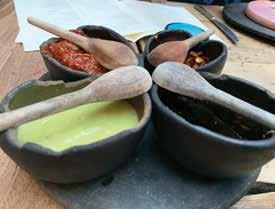
BY GREG KLASSEN
Advertisement
One mild day last January, I was strolling down leafy Amsterdam Avenue in Mexico City’s super-chill La Condesa neighbourhood, and wondered, “Am I really in the world’s largest city?” If you imagine Mexico’s largest city as smoggy, crime-ridden, and soulcrushingly enormous, Mexico City may surprise you.
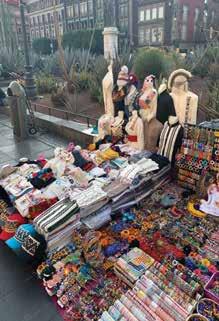
While the traffic and pollution in Mexico City (often abbreviated locally to CDMX) are real, there’s another side to the city that makes it worth more than a launching pad to your beach destination. My partner and I spent four nights at the Red Tree House, a four-star bed and breakfast tucked into a quiet neighbourhood.
We were lucky enough to see the city through the eyes of an expert guide, Brenda, a young woman who has lived in Mexico City her entire life. We only had five days, and our strategy was to spend a day in each of the city’s most tourist-friendly neighbourhoods. A secondary mission was to look for places of calm within the city’s heart.
We spent our day wandering around, pausing when we found the street where the movie Roma was filmed, or to watch people literally dance in the streets, or sampling the abundance of delicious street food. Overhead the jacaranda trees had started to bud, with their purple leafs creating a shocking canopy (it was January!) And always, the quiet, strollable neighbourhoods like Roma Norte and La Condesa offered a respite from the city’s manic energy.
Mexico City has a rich and colourful past. Many of the historic buildings feature murals documenting that history. In fact, it’s really many cities within a larger city. The neighbourhoods are incredibly distinct, from funky, affluent Coyoacan, where Frida and Diego crafted their masterpieces, to the beautiful historical centre with its many palaces, churches, upscale restaurants and hotels of Polanco.
The historical centre, dubbed El Centro by locals, is densely packed with cathedrals, palaces, parks and tourists. Hands down the most beautiful building is the white marble main concert hall Bellas Artes. Pay the small fee to enter its art deco interior and walk to the top of the stairs, where you’ll be spellbound by the rich colours and sad history depicted in Diego Rivera’s sweeping murals.
One of the most infamous paintings in art history - Man, Controller of the Universe - was a mural originally commissioned to Rivera at NYC’s Rockefeller Centre, only to have it labelled “obscene.” (It was either an image of Lenin that Rivera refused to remove or a likeness to Rockefeller himself that was the problem).
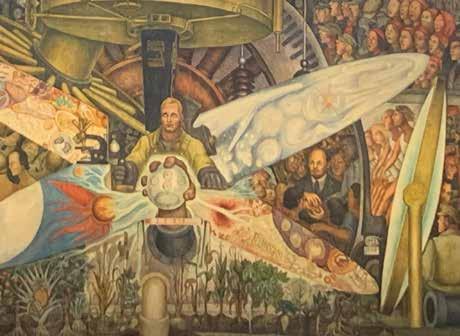
Rockefeller had the mural chiselled off the wall, but Rivera got his revenge by creating a new version at Bellas Artas.
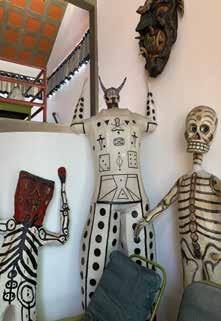
The massive mural requires time to take it all in. The unemployed watch wealthy women play cards while war rages, and the natural world continues to grow in the foreground, apparently unaffected. An angry Jupiter hovers above, with a raised hand holding a thunderbolt severed by a lightning strike. At the centre is a workman in control of a giant set of four propellers.
If you can’t get enough Rivera, there’s Colegio de San Ildefonso, a lesser-known attraction where the Mexican mural movement all started. Closed in 1978, the colonial-style former Jesuit boarding school reopened as a museum in 1992. Our guide confessed that she would beg her parents to bring her here as a young girl. The quadrangle structure with gardens in the center provides a contemplative place to find some peace in the heart of the city. Colegio also features many works by Orozco and Siqueiros, as well as temporary art exhibits.
If you’re wondering where’s Frida in all of this? I’ll admit my luck in seeing her legacy of work wasn’t stellar. It was our choice to skip Frida Kahlo’s famous Casa Azul (Blue House), most- ly to avoid the long lineups. Instead, we decided to visit Casa Estudio Diego Rivera Y Frida Kahlo, the two studios where Diego and Frida created most of their art. The bridge at the top of their houses is its most unique architectural feature. One can easily picture the legendary artist traversing it with her husband’s dinner. Designed by legendary architect Juan O’Gorman, the compound is protected by a geometrically pleasing hedge of cactuses. The workshops provide a glimpse into the lives of these artistic legends, with paper mache skeletons, pre-Columbian pottery and scattered paintbrushes filling the large studios.

From street food to high-end restaurants, there is an incredible array of delicious cuisine in Mexico City. Café NIN was our happy place for breakfast. They served fresh baked goods such as Amaranth and Blueberry Cookies, Quinoa and Flaxseed Muffins and Chocolate and Hazelnut Berliners.
While Pujol is generally acknowledged as Mexico City’s finest restaurant, you don’t have to break the bank to eat like a king. My favourite restaurant was Tetetlan, in the spectacularly renovated former stable of artist Luis Barragán. The restaurant specializes in fish tacos amongst other exquisite cuisine. Tetetlan has exposed brick walls and glass floors, with views of the volcanic rock below, and also houses a library, yoga studio and clothing store.
In the city centre, the restaurant El Mayor features an aerial perspective of the archeological zone of Templo Mayor and the majesty of colonial Mexico. The building-long open window overlooking the ruins is a delightful place to sit and have a cocktail or snack after a day of jostling with the crowds below.

If you’re strolling Colima Street, you won’t need the street address to locate Rosetta, with lineups down the street for its legendary baking and java. Another highlight was Taverna, housed in a historical hacienda that’s shabby chic and lit by candlelight. The Mediterranean-inspired dishes are roasted in a wood-burning oven and the cocktails are inventive and super tasty.
Many tourists pass on Museo Anahuacalli because of its considerable drive from the city centre. Those who do go will be rewarded with a design that resembles an Aztec temple, made out of volcanic stone. The museum houses Rivera’s extensive collection of pre-Hispanic art. Rivera’s politics may have leaned toward socialist, but he was a very wealthy man. Co-designed by Frank Lloyd Wright and situated on a hill, the museum also offers impressive views of the city.
The Museo Nacional de Antropologia is the largest and most visited museum in the city. Containing many significant archaeological artifacts from Mexico’s pre-
Columbian heritage, including the Aztec calendar stone, it’s an unforgettable experience. If you’re up for a night of dancing and drinking, Club San Luis is lit in retro red, with a very energetic live band offering the chance to learn to dance cumbia and salsa.
Mexico City is a place with a beating heart. The food and art scenes are pulsing with life and energy. It is also in the same time zone as Winnipeg, so you can get off your flight and join right in the fun.
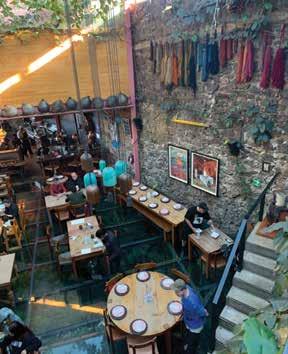
Greg Klassen is a Winnipeg arts lover, travel writer and garden afficionado.










